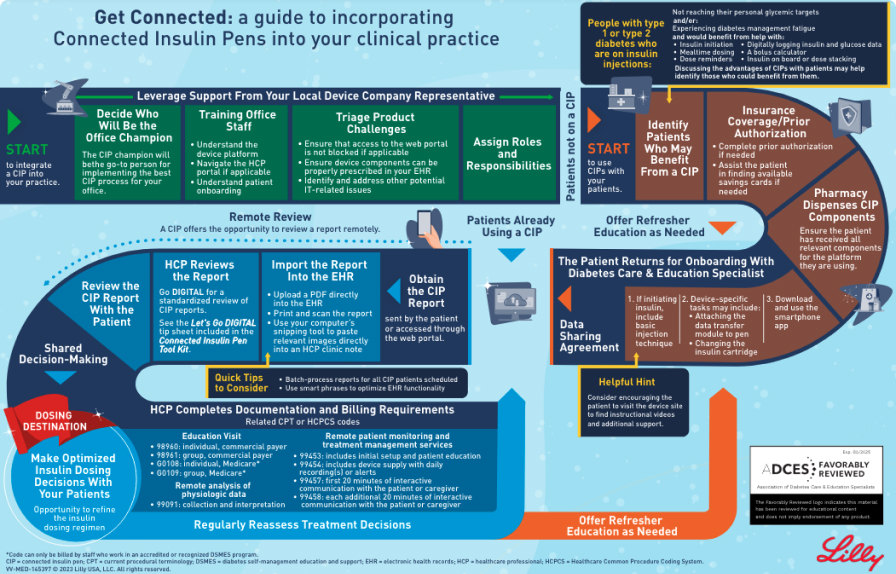Connected Insulin Pen (CIP) Toolkit
Integration of Connected Insulin Pens (CIPs) Into Clinical Practice
CIPs can help identify suboptimal insulin dosing patterns, such as missed doses, mistimed doses, and inadequate doses, which are often not apparent with glucose data alone. Integrating CIP technology into an office’s workflow allows healthcare professionals to capitalize on these valuable insights and optimize insulin dosing decisions with their patients.
The Get Connected guide outlines key steps, along with some helpful hints, to help you incorporate CIPs into your clinical practice:
- Device company representatives
- Office champions
- Roles and responsibilities
- Patients who may benefit from a CIP
- Insurance coverage and pharmacy delivery
- Diabetes care and education specialists
- Import into electronic health records
- Remote review
- Shared decision-making
Dr David Ahn walks through the Get Connected guide for incorporating CIPs into your clinical practice.
Welcome! My name is David Ahn. I am a board-certified adult endocrinologist and program director at Mary & Dick Allen Diabetes Center for Hoag Memorial Hospital Presbyterian in Newport Beach, California. I love using technology to help empower patients and improve their ability to manage their diabetes.
In this video, I will walk through a workflow designed to help guide you in the process of integrating connected insulin pens, or CIPs, into your clinical practice.
CIPs are becoming an important part of diabetes care, as they have grown more common among patients with diabetes who are taking insulin injections. CIPs capture and transmit insulin dose–related information to a compatible smartphone application and, in some cases, an HCP portal. Integrating insulin and glucose data through CIPs allows HCPs to make more informed dosing decisions.
Follow me through Get Connected: a guide to incorporating Connected Insulin Pens into your clinical practice.
Let’s start with the steps to introduce a CIP platform into your practice.
First, decide which staff member will be the office champion who helps implement the workflow to integrate CIPs into your clinic. This might be a manager or a support staff member.
Next, complete training with office staff to ensure everyone’s understanding of the device platform. Before prescribing the CIP to patients, you'll want to identify and address any product or IT-related challenges. It is important to ensure that device components can be properly prescribed in your electronic health records and, if applicable, access to the web portal is not blocked.
Then roles and responsibilities can be assigned.
For all the steps we’ve just covered, leveraging support from your local CIP device company representative can help streamline the process.
Now you’re ready to start using CIPs with your patients.
To do so, start by identifying which patients could benefit from this technology.
This may include your patients with diabetes who are on insulin injections and not reaching their personal glycemic targets or patients who are experiencing diabetes management fatigue.
These patients may benefit from assistance with insulin initiation, mealtime dosing, dose reminders, or digitally logging insulin and glucose data.
Discussing the advantages of a CIP with patients may help identify those who could benefit from one.
Once you and your patient have decided that a CIP could help them, there may be some things to consider.
The first is coverage of the device. Some insurance providers may require prior authorization of the CIP or its components. CIP manufacturers may offer savings cards that can help.
When the pharmacy dispenses the CIP to the patient, ensure that they receive all the necessary components.
Once the patient has received their CIP, they are ready for onboarding. Many would benefit from an appointment with a certified diabetes care and education specialist, as it is important for patients to confidently understand device-specific tasks and the smartphone app.
Once the patient has been trained and is now using their CIP, it’s important to create a workflow by which a patient’s CIP report is downloaded and shared with the provider, either by accessing the HCP web portal or receiving it directly from the patient.
Visit preparation can start with downloading a patient’s CIP report by accessing the HCP web portal or receiving it directly from the patient.
It may be helpful to import the information from the report into your electronic health records.
If time allows, review patient reports before each visit. Then, during the visit, review important items from the report with your patient. You can also review CIP reports remotely, allowing for treatment decisions to be made between clinic visits.
A helpful resource for this process is the Let’s Go DIGITAL tip sheet included in the Connected Insulin Pen Tool Kit.
Finally, through shared decision-making with your patients, you can optimize insulin dosing plans together. Whatever treatment decisions are agreed upon, the data a CIP provides can help your patients get the right dose at the right time.
Just remember that this process is cyclical, and all treatment decisions should be reassessed regularly.
This concludes our walkthrough of Get Connected: a guide to incorporating Connected Insulin Pens into your clinical practice.
I hope these steps will assist in streamlining the process of incorporating CIPs into your practice and prescribing them to your patients.
Thank you for watching!
VV-MED-154647
Please rate your satisfaction with the content on the following statements:
Very Dissatisfied
Dissatisfied
Neutral
Satisfied
Very Satisfied
